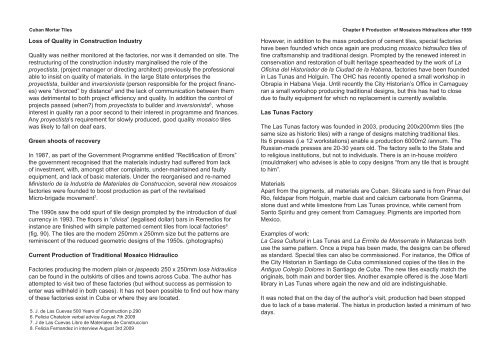Cuban Mortar Tiles - infogram.co.uk > Home
Cuban Mortar Tiles - infogram.co.uk > Home
Cuban Mortar Tiles - infogram.co.uk > Home
You also want an ePaper? Increase the reach of your titles
YUMPU automatically turns print PDFs into web optimized ePapers that Google loves.
<strong>Cuban</strong> <strong>Mortar</strong> <strong>Tiles</strong> Chapter 8 Production of Mosai<strong>co</strong>s Hidrauli<strong>co</strong>s after 1959<br />
Loss of Quality in Construction Industry<br />
Quality was neither monitored at the factories, nor was it demanded on site. The<br />
restructuring of the <strong>co</strong>nstruction industry marginalised the role of the<br />
proyectista, (project manager or directing architect) previously the professional<br />
able to insist on quality of materials. In the large State enterprises the<br />
proyectista, builder and inversionista (person responsible for the project fi nances)<br />
were “divorced” by distance 5 and the lack of <strong>co</strong>mmunication between them<br />
was detrimental to both project effi ciency and quality. In addition the <strong>co</strong>ntrol of<br />
projects passed (when?) from proyectista to builder and inversionista 6 , whose<br />
interest in quality ran a poor se<strong>co</strong>nd to their interest in programme and fi nances.<br />
Any proyectista’s requirement for slowly produced, good quality mosai<strong>co</strong> tiles<br />
was likely to fall on deaf ears.<br />
Green shoots of re<strong>co</strong>very<br />
In 1987, as part of the Government Programme entitled “Rectifi cation of Errors”<br />
the government re<strong>co</strong>gnised that the materials industry had suffered from lack<br />
of investment, with, amongst other <strong>co</strong>mplaints, under-maintained and faulty<br />
equipment, and lack of basic materials. Under the reorganised and re-named<br />
Ministerio de la Industria de Materiales de Construccion, several new mosai<strong>co</strong>s<br />
factories were founded to boost production as part of the revitalised<br />
Micro-brigade movement 7 .<br />
The 1990s saw the odd spurt of tile design prompted by the introduction of dual<br />
currency in 1993. The fl oors in “divisa” (legalised dollar) bars in Remedios for<br />
instance are fi nished with simple patterned cement tiles from local factories 8<br />
(fi g. 90). The tiles are the modern 250mm x 250mm size but the patterns are<br />
reminiscent of the reduced geometric designs of the 1950s. (photographs)<br />
Current Production of Traditional Mosai<strong>co</strong> Hidrauli<strong>co</strong><br />
Factories producing the modern plain or jaspeado 250 x 250mm losa hidraulica<br />
can be found in the outskirts of cities and towns across Cuba. The author has<br />
attempted to visit two of these factories (but without success as permission to<br />
enter was withheld in both cases). It has not been possible to fi nd out how many<br />
of these factories exist in Cuba or where they are located.<br />
5. J. de Las Cuevas 500 Years of Construction p.290<br />
6. Felicia Chateloin verbal advice August 7th 2009<br />
7. J de Las Cuevas Libro de Materiales de Construccion<br />
8. Felicia Fernandez in interview August 3rd 2009<br />
However, in addition to the mass production of cement tiles, special factories<br />
have been founded which once again are producing mosai<strong>co</strong> hidrauli<strong>co</strong> tiles of<br />
fi ne craftsmanship and traditional design. Prompted by the renewed interest in<br />
<strong>co</strong>nservation and restoration of built heritage spearheaded by the work of La<br />
Ofi cina del Historiador de la Ciudad de la Habana, factories have been founded<br />
in Las Tunas and Holguin. The OHC has recently opened a small workshop in<br />
Obrapia in Habana Vieja. Until recently the City Historian’s Offi ce in Camaguey<br />
ran a small workshop producing traditional designs, but this has had to close<br />
due to faulty equipment for which no replacement is currently available.<br />
Las Tunas Factory<br />
The Las Tunas factory was founded in 2003, producing 200x200mm tiles (the<br />
same size as historic tiles) with a range of designs matching traditional tiles.<br />
Its 6 presses (i.e 12 workstations) enable a production 6000m2 /annum. The<br />
Russian-made presses are 20-30 years old. The factory sells to the State and<br />
to religious institutions, but not to individuals. There is an in-house moldero<br />
(mouldmaker) who advises is able to <strong>co</strong>py designs “from any tile that is brought<br />
to him”.<br />
Materials<br />
Apart from the pigments, all materials are <strong>Cuban</strong>. Silicate sand is from Pinar del<br />
Rio, feldspar from Holguin, marble dust and calcium carbonate from Granma,<br />
stone dust and white limestone from Las Tunas province, white cement from<br />
Santo Spiritu and grey cement from Camaguey. Pigments are imported from<br />
Mexi<strong>co</strong>.<br />
Examples of work:<br />
La Casa Cultural in Las Tunas and La Ermite de Monserrate in Matanzas both<br />
use the same pattern. Once a trepa has been made, the designs can be offered<br />
as standard. Special tiles can also be <strong>co</strong>mmissioned. For instance, the Offi ce of<br />
the City Historian in Santiago de Cuba <strong>co</strong>mmissioned <strong>co</strong>pies of the tiles in the<br />
Antiguo Colegio Dolores in Santiago de Cuba. The new tiles exactly match the<br />
originals, both main and border tiles. Another example offered is the Jose Marti<br />
library in Las Tunas where again the new and old are indistinguishable.<br />
It was noted that on the day of the author’s visit, production had been stopped<br />
due to lack of a base material. The hiatus in production lasted a minimum of two<br />
days.



